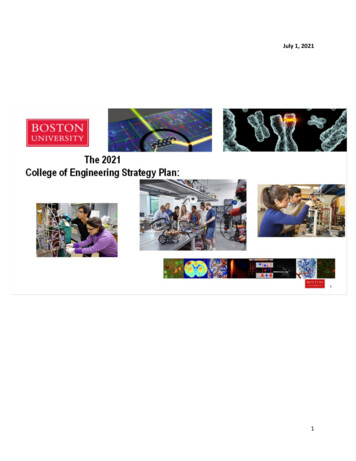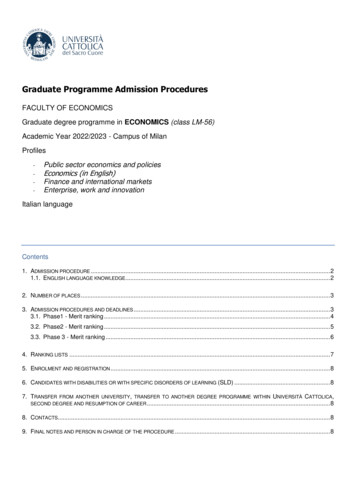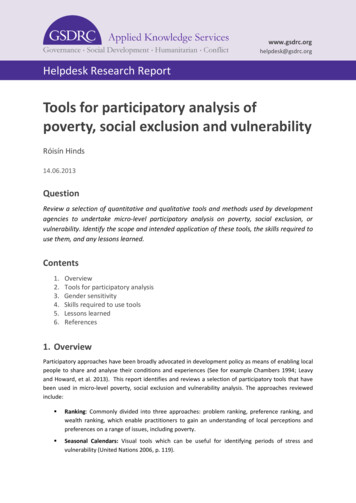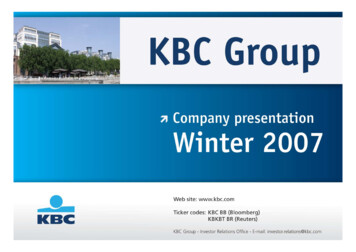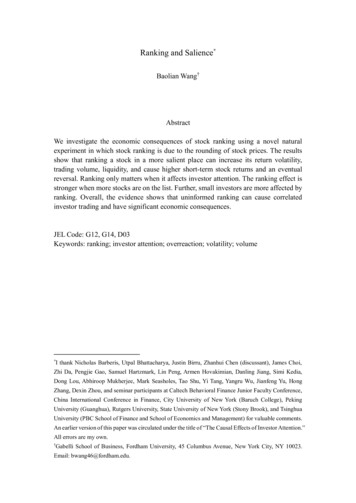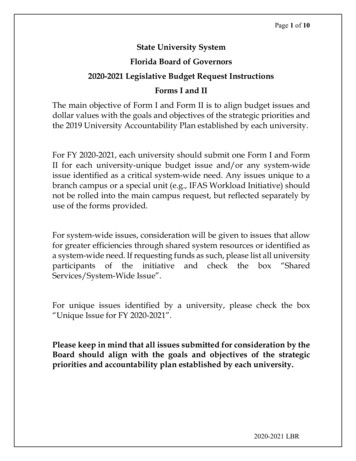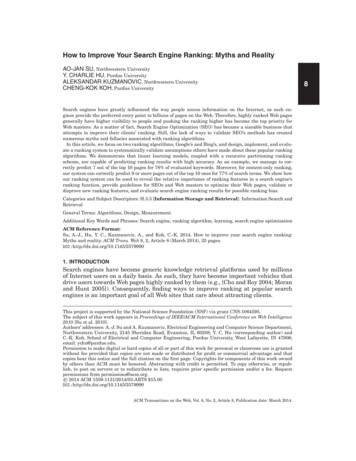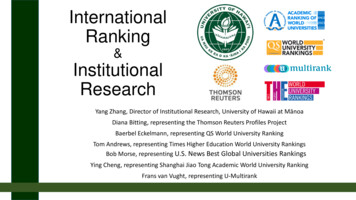
Transcription
InternationalRanking&InstitutionalResearchYang Zhang, Director of Institutional Research, University of Hawaii at MānoaDiana Bitting, representing the Thomson Reuters Profiles ProjectBaerbel Eckelmann, representing QS World University RankingTom Andrews, representing Times Higher Education World University RankingsBob Morse, representing U.S. News Best Global Universities RankingsYing Cheng, representing Shanghai Jiao Tong Academic World University RankingFrans van Vught, representing U-Multirank
Panel Discussion Preview Perspectives from Major International Rankings Diana Bitting, representing the Thomson Reuters Profiles ProjectBaerbel Eckelmann, representing QS World University RankingTom Andrews, representing Times Higher Education World University RankingsBob Morse, representing U.S. News Best Global Universities RankingsYing Cheng, representing Academic World University RankingFrans van Vught, representing U-Multirank Perspective of Institutional Research Case Study at the University of Hawai’i at Manoa
Why We Care about International Rankings? Recruit Students and Talent Globally Global Employment Market Expanding Institutional and Program LevelCollaboration Globally University Community EngagementKeywords: Marketing and Promotion
Global Institutional Profiles ProjectDiana Bitting,Team Lead,Institutional Data Collection
The global Institutional Profiles project The global Institutional Profiles project is an initiative to collectfactual data about academic institutions in all regions for thepurposes of creating informative profiles of their activities. The objective is to profile more than 1,000 of the leadingacademic institutions around the world. Current use of the Profiles Project data includes informing the U.S.News Best Global University Ranking. Thomson Reuters bibliometric data informs other rankings such asU-MultiRank, the CWTS Leiden Ranking and the Shanghai JiaoTong Academic World University Ranking
Thomson Reuters Profiles Project Three main sources of ataBibliometricdataProfiles Project
Thomson Reuters Profiles Project Academic Reputation Survey Conducted by 3rd party market research and survey specialist, IPSOS, andruns annually during the spring anonymous invitations to 350,000 researchers and academics carefully selected addresses, balanced to account for varying regional andsubject level strength Institutional Data Collection run annually during the spring, typically April-May via a dedicated data collection portal Bibliometric Data – sourced from Thomson ReutersWeb of Science TM research discovery and analytics
Thomson Reuters Profiles ProjectWhen and how was your ranking system developed?Profiles Project is in year 6 – visit this link to read all about ilesproject/In what ways is your ranking system different from other international rankings?TR allows the ranking service itself to define the ranking methodology and data use.In what ways is the institutional research office involved?University institutional research departments are our first and only point of contact for data collection.What is a typical data collection and ranking release timeline?U.S. News Best Global Universities – Fall 2015How can universities use Ranking data?Profiles are utilized by universities, funding agencies, governments and rankings agencies as a valuable tool to identifyweaknesses and strengths, find peer institutions, compare to global or regional benchmarks and to promote achievements totheir stakeholders.What strategies can universities use to maintain or improve their ranking?Institutions are encouraged to consider a number of ranking results, keeping in mind the nature of the ranking methodology.One size does not fit all and a ranking position alone does nothing to help a university learn where it fits against all otheruniversities in a ranked group. Regardless of ranking position, underlying indicators can be taken on individually and used toevaluate current conditions or drive decisions about future directions.Ranking services can help universities focus their efforts in particular areas where improved performance is desired. Strategiesfor improvement such as greater focus on high quality research, efforts to hire the best faculty and leadership staff, ensuringthat academics and administrators are clear about the university strategy, among others, are worthy university improvements,not simply Ranking position improvements.
QS World University RankingsBaerbel Eckelmann,Research Manager,QS Intelligence Unit
MOTIVATEDPEOPLETo enableto achieve theirby fosteringaround EMENTandCAREERDEVELOPMENT
QS StarsLaunch of THES-QSWURQS Intelligence Unitestablished200120042007QS UniversityRankings: BRICS2008QS UniversityRankings: Asia20092010QS UniversityRankings: LatinAmerica2011First subject tablesQS introduces four keyenhancements tomethodologyQS and Times HigherEducation choose to gotheir separate ways.THE announcesintention to initiate anew ranking.QS UniversityRankings: EECAQS BestStudent Cities20122013International RankingsExpert GroupObservatory onAcademic Ranking andExcellence decided togrant rights to use“IREG Approved” labelin relation to the QSWUR and QS WUR:Latin America and QSWUR: AsiaQS UniversityRankings: ArabRegion20142015
OUR DENTSEMPLOYERSALUMNIGOVERNMENTUNIVERSITYLEADERS
OUR APPROACHWORLDCLASSUNIVERSITYA UNIQUE LENSQS the only global rankingauthority to consider itCentral to the life goals ofmost prospective studentsAn essential inclusion inevery QS assessment
ACADEMICREPUTATIONEMPLOYERREPUTATION Consistent,simplemethodology Stableresults DisciplineINT’LFACULTYindependent LanguageindependentFACULTYSTUDENTCITATIONSPER FACULTY Lowdependenceon self-reportingpowered byINT’LSTUDENTS
NOVEMBERInvitation to supplyacademic andemployer contactdetail listsFEBRUARYJULYAUGUSTSEPTEMBERData submissionrequestData submissioncut-offData analysisQS WURlaunch
FIRST INGREDIENTSUSTAINEDMISSION AGILETRANSPARENTFINANCIALLEADERSHIP
SECOND INGREDIENTALL THINGS TOALL PEOPLE?ELEPHANT OGYSUSTAINABLENETWORKLEVERAGEUNIQUERECOGNITION
THIRD PLEDISTINCTIVESTRIKINGSPECIFIC
FOURTH INGREDIENTINDUSTRYHARD WORKCOLLABORATEDIVERSITYINTER-NATIONALTOP DOWN?BOTTOM UP?IN FOR A PENNY?ABOVE ANDBELOW
FIFTH INGREDIENTTRUST NO QUICK FIXESLARGEOPERATIONRANKINGS LAGOTHERSWORKING TOOFOR THESTUDENTS
Times Higher Education World University RankingsTom Andrews,Data Director,Times Higher Education
Submit nowto be part of theWorld University RankingsSurveymonkey.com/s/WURdataHurry, the rankings are closing soon
U.S. News Best Global Universities RankingsBob Morse,Chief Data Strategist,U.S. News & World Report
Best Global Universities rankingsFAQ Inaugural U.S. NewsBest Global Universitiesrankings launched onusnews.com on October28, 2014. The Best GlobalUniversities rankingsare powered by datafrom Thomson ReutersInCitesTM researchanalytics solutions.
Best Global Universities rankingsFAQ Weights and ranking factors weredeveloped by U.S. News Methodology focused on institution’sresearch performance using 10factors: global and regionalreputation, bibliometric indicatorsand school level data
Best Global Universities rankingsFAQBest Global Universities rankings include: Top 500 Universities worldwide in 49 countries Four regional rankings - Asia, Australia/New Zealand, Europeand Latin America 11 country rankings – of the top institutions in: Canada,China, France, Germany, Italy, Japan, the Netherlands, SouthKorea, Spain, Sweden and the United Kingdom Top 100 universities in 21 subjects in such key fields aschemistry, clinical medicine, computer science, economics andbusiness, engineering, environment/ecology, mathematics andphysics.
Best Global Universities rankingsThe 10 ranking factors and weights used in overall BestGlobal Universities rankings.Ranking indicatorGlobal research reputationRegional research reputationPublicationsNormalized citation impactTotal citationsNumber of highly cited papersPercentage of highly cited papersInternational collaborationNumber of Ph.D.s awardedNumber of Ph.D.s awarded per academicstaff memberWeight12.5%12.5%12.5%10%10%12.5%10%10%5%5%
Best Global Universities rankingsBest Global UniversitiesBest Global Universities -The Top 202015 Best Global Top 500 UniversitiesNameHarvard UniversityMassachusetts Institute of TechnologyUniversity of California--BerkeleyStanford UniversityUniversity of OxfordUniversity of CambridgeCalifornia Institute of TechnologyUniversity of California--Los AngelesUniversity of ChicagoColumbia UniversityJohns Hopkins UniversityImperial College LondonPrinceton UniversityUniversity of MichiganUniversity of TorontoUniversity of WashingtonYale UniversityUniversity of California--San DiegoUniversity of PennsylvaniaDuke UniversityCountryUnited StatesUnited StatesUnited StatesUnited StatesUnited KingdomUnited KingdomUnited StatesUnited StatesUnited StatesUnited StatesUnited StatesUnited KingdomUnited StatesUnited StatesCanadaUnited StatesUnited StatesUnited StatesUnited StatesUnited StatesRegionNorth AmericaNorth AmericaNorth AmericaNorth AmericaEuropeEuropeNorth AmericaNorth AmericaNorth AmericaNorth AmericaNorth AmericaEuropeNorth AmericaNorth AmericaNorth AmericaNorth AmericaNorth AmericaNorth AmericaNorth AmericaNorth AmericaOverall Rank1234567891011121314141417181920
Best Global Universities rankingsFAQTop 11 countries account for 77 percent of the Top 5002015 Best Global Universities Rankings Country CountsNumber of universities in Percent of universities inCountrytop 500top 500U. S.13426.8%Germany428.4%United 6%Spain122.4%South Korea112.2%Sweden102.0%
Best Global Universities rankingsMethodology used to rank the 21 Subjects: The soft sciences are computerscience; economics and business; engineering; and social sciences andpublic health in addition to math; all others are hard sciences.Ranking indicatorWeights used forsoft sciencesWeights used forhard sciencesGlobal research reputation12.5%12.5%Regional research reputation12.5%12.5%17.5%15%Normalized citation impact7.5%10%Total citations12.5%15%Number of highly cited papers17.5%15%Percentage of highly citedpapers10%10%International collaboration10%10%Publications
Best Global Universities rankingsFAQTop Countries in 21 Subject Rankings2015 Country Counts for Best Global Universities Subject RankingsCountryUnited StatesUnited eJapanSwitzerlandSwedenSpainHong KongItalySouth KoreaBelgiumDenmarkTaiwanSingaporeIsraelNumber of Schools Ranked in Subjects Percent of Schools Ranked in 81%
Academic Ranking of World Universities (ARWU)Ying Cheng,Executive Director,Center for World-Class Universities,Shanghai Jiao Tong University
Academic Ranking of World Universities (ARWU)by Shanghai Jiao Tong University ARWU was first published in 2003, by the Center for World-ClassUniversities (CWCU) of Shanghai Jiao Tong University. All the data used in ARWU is from third parties and publicly available,ARWU does not use data directly from universities. ARWU does not use data from universities. However, CWCU started aproject called “Global Research University Profiles (GRUP)” in 2011.Through GRUP project, universities are asked to report data on theirstaff, students and finances. ARWU usually is published on August 15th. GRUP survey usually open for data submission during March to May.
U-MultirankFrans van Vught,the Center for Higher Education Policy Studies (CHEPS),Netherlands
U-Multirank U-Multirank is prepared with seed funding from the European Unionand led by a consortium headed by Professor Dr. Frans van Vught ofthe Center for Higher Education Policy Studies (CHEPS) in theNetherlands and Professor Dr. Frank Ziegele of the Centre for HigherEducation (CHE) in Germany. U-Multirank is a new multi-dimensional, user-driven approach tointernational ranking of higher education institutions. The dimensionsit includes are teaching and learning, research, knowledge transfer,international orientation and regional engagement.
Interview:https://www.youtube.com/watch?v ZmqXmhGpnQA
Perspectives from International Rankings(Handout) Brief Introduction of Each Ranking How Rankings Were CreatedUniqueness of Each RankingData Collection (In What Ways is Institutional Research involved?)Timeline (Data Collection and Ranking Release) Recommendations for Using International Rankings What Strategies can Universities Use to Maintain or Improve TheirRanking?
Perspectives from Institutional Research Campus Stakeholders Chancellor and Vice ChancellorsEnrollment and Planning / AdmissionDeans and ChairsCommunication/AdvancementGeneral Public / Media / Legislature Data Preparation Difference in Data Preparation Automate the Data Preparation Process Communication and Trainings IR Website Campus-wide Trainings Communication Strategies
IR Strategy 1: Focus on Specific RankingsBalance Capacity and Importance:From the “Ranking Laundry List” to Six Major Rankings
IR Strategy 2: Rank the Rankings Legitimacy of Ranking Organizations Influence of Rankings(Media Coverage: an audience is truly global) Ranking Methodology How Well are We Ranked?
Ranking Page onthe IR OfficeWebsite atUniversity ofHawai’i at Mānoa
Provide Sufficient and Relevant Ranking Information
Prestigious International Ranking
IR Strategy 3: Encourage Academic Units toDevelop Effective Communication Strategies Keep Close Track of Rankings Timely and Accurate Ranking Information on MIRO Website’s RankingPage: http://manoa.hawaii.edu/miro/rankings/ Collaborate with the Communications Office Promote through Your Own Venues College and Department Website Student or Alumni Newsletters Recruitment Efforts
IR Strategy 4: Institutional LevelPractical Approaches towards Rankings Be Aware of the Importance of Rankings, Especially the InternationalRankings. Keep Close Track of Rankings and Make the Best Use of Them. Be Aware of the increasingly large quantity of National or InternationalRankings. Each Ranking has Unique Purposes and Methodologies. It isRecommended to Talk About Our University’s Performance in VariousRankings, Rather than Focusing on Changes in One Specific Ranking. Be Aware of the “Rankings Game.” Our Institution Establishes StrategicDirections and Metrics Based on the Needs of the State. Rankings are notOur University’s Priority. Notify the IR Office What Should or Should Not be Put on the Ranking Page.
Recommendations for Institutional Researchers Gain Better Understanding about International Rankings Review and Compare Data Preparation Methods Develop Appropriate Ranking Communication Strategies Want to Know More about International Ranking? International Ranking Expert Group (IREG) Observatory Ranking Websites Ranking Conferences
Upcoming Ranking Conferences IREG Forum: Subject and Discipline Related Rankings--6/11-12, 2015; Aalborg, Denmark Shanghai Jiao Tong Ranking: World Class University Conference--11/1-4, 2015; Shanghai, China QS-APPLE: November, 2015; Melbourne QS Reimagine Education Conference: 12/7-9; Philadelphia Time Higher Education World Rankings Released inMelbourne, October, 2015
Diana Bitting, representing the Thomson Reuters Profiles Project Baerbel Eckelmann, representing QS World University Ranking Tom Andrews, representing Times Higher Education World University Rankings Bob Morse, representing U.S. News Best Global Universities Rankings Ying Cheng, representing Shanghai Jiao Tong Academic World University Ranking
